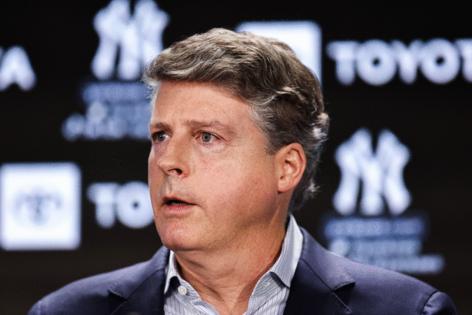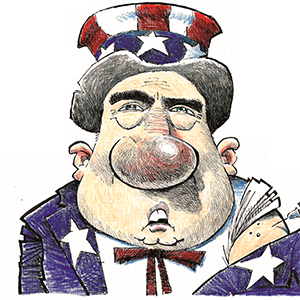Yankees' Steinbrenner says lower payroll 'ideal' if unlikely, questions club's profitability
Published in Baseball
NEW YORK — The last time Hal Steinbrenner held a press conference, he primarily focused on his decision to trim the New York Yankees’ long-standing ban on facial hair, which his father, George, implemented in the 1970s.
On Monday, however, Steinbrenner was repeatedly asked about potentially shaving his team’s payroll as he spoke to reporters in a group setting for the first time since February. The owner addressed several other topics, including his team’s shortcomings in 2025, but finances dominated the conversation.
Most notably, Steinbrenner said “of course” it would be “ideal” to lower payroll after stating the Yankees ended up at $319 million for the 2025 season. That doesn’t make such a goal likely, though.
“Does that mean that’s going to happen? Of course not,” Steinbrenner continued after declining to announce a target budget. “We want to field a team we know could win a championship, or we believe could win a championship.
“Payroll has gone up probably every year. It doesn’t mean it won’t go slightly down one year and then up the year after that. It all depends on what’s out there and what the possibilities are and how much I feel we’re able – or we need – to pull the trigger on those possibilities.”
Steinbrenner has previously called $300 million payrolls unsustainable, but he has cleared that number for competitive balance tax purposes the past two seasons.
According to Cot’s Contracts’ projections, the Bombers’ 2024 payroll was just over $316 million, and they paid over $66 million in penalty taxes per season in 2024 and 2025.
The second-highest threshold for competitive balance tax penalties is $284 million next season, while the highest threshold is $304 million. As of Monday morning, the Yankees’ projected competitive balance tax payroll for 2026 was $278.1 million, per Cot’s. That ranked second in baseball behind the back-to-back champion Dodgers ($314.8 million) and accounted for Trent Grisham’s $22.025 qualifying offer, Ryan Yarbrough’s $2.5 million contract, Tim Hill’s $3 million club option and the non-tendering of five relievers, including Mark Leiter Jr.
The Yankees are still pursuing a reunion with Cody Bellinger, who is expected to sign a nine-figure deal. They also need bullpen and bench pieces, and they would benefit from adding a frontline starter.
Steinbrenner said, “I really love our starting rotation next year” once Gerrit Cole and Carlos Rodón return from injuries in the early part of the season, barring any setbacks. But he also repeated evergreen statements, saying the Yankees would keep all of their options open and that general manager Brian Cashman should present all possibilities.
“We can talk before [Cashman] goes into the Winter Meetings [in December] about a range,” Steinbrenner said of the payroll, “but because it’s a fluid situation, that range can go bye-bye in two seconds if there’s a deal that arises that I feel would be very beneficial to some area of need that we have. It’s hard to give you a number.”
When asked last week if it’s realistic for the Yankees to stay under $300 million and fill out their roster the way they need to, Cashman said, “I think it could go both ways.”
Labor concerns?
Steinbrenner, echoing comments previously shared by Cashman, also said that potential future changes to the sport’s economic model and concerns over a potential work stoppage – the collective bargaining agreement expires after the 2026 season – will not impact how the Yankees approach this offseason.
He did, however, reiterate he would consider supporting a salary cap – something owners generally want and players have long stood against – so long as it comes with a salary floor “that would be reasonable enough that it would improve competitive balance significantly in the sport, which many fans would argue is not good enough.”
“We’ll always be among the highest payroll-wise,” Steinbrenner added. “We always have been, always will be. Look, there’s groups of fans out there in different areas, including my hometown here in Tampa – I’ve addressed this before – that come to spring training thinking their team has little chance of making the playoffs. Those fans would argue that’s not good for baseball as a whole. It’s a valid argument, whether it’s true or not.”
Do the Yankees make money?
Steinbrenner did argue against perceptions of his profits as he was quizzed about his payroll plans.
At one point, Steinbrenner was asked, “I’ve seen it suggested that your revenues were over $700 [million], so I’m assuming you make a profit. Is that fair as well?”
Steinbrenner replied, “No, it’s not fair, actually.”
“So you take a loss,” the reporter asked in a follow-up.
“I don’t want to get into it. But that’s not a fair statement or an accurate statement. Everybody wants to talk about revenues. They need to talk about our expenses, including the $100 million expense to the city of New York that we have to pay every Feb. 1, including the COVID year,” Steinbrenner said, referring to the payment-in-lieu-of-taxes (PILOT) bonds used to pay for Yankee Stadium. “It all starts to add up in a hurry. Nobody spends more money, I don’t believe, on player development, scouting, performance science. These all start to add up. If you want to go look at the revenues, you got to somehow try to figure out the expense side as well. You might be surprised.”
It wasn’t completely clear whether Steinbrenner was implying the Yankees are not profitable or if merely the $700 million revenue figure was inaccurate, and the Yankees obviously will not be opening their books to the public to check. But Steinbrenner’s refusal to clarify whether or not the Yankees are profitable invites an interpretation that the team does, in fact, lose money — an incredible notion — ahead of what is certain to be a bloody labor battle next winter.
When asked later on if he said the Yankees didn’t make money in 2025, Steinbrenner responded, “I’m not gonna get into our finances. I simply said what he implied was not correct.”
Fans, of course, are not concerned with Steinbrenner’s profits with their team in the midst of a 16-year championship drought, the second-longest in Yankees history. After seeing their team get bounced by the Toronto Blue Jays in the ALDS last month, they expect the owner to address the club’s needs, costs be damned.
Keeping up with the Dodgers
While the Yanks have been among the league’s highest spenders for decades, they have trailed the Dodgers and/or Mets in recent seasons, including this past one. Steinbrenner was quick to point out that the Queens club ($338.2 million payroll in 2025) didn’t even make the playoffs, but the Yankees watched the Dodgers ($415.2 million) beat Toronto for their second championship in a row after defeating the pinstripers in the 2024 Fall Classic.
“If there’s a correlation between spending the most money and winning a championship, I still think it’s a weak correlation and sample size of data. But they earned every bit of it,” Steinbrenner said of the Dodgers after previously questioning whether their payroll would pay off.
Yet he added, “But again, we’ll see what they do next year and we’ll see how it pans out. There was nothing low about my payroll and the Mets’ payroll. Look where we ended up.”
At this point, there is a segment of the Bronx faithful – as well as other fanbases – that is worried the ultra-affluent Dodgers are pulling away from the Yankees and the rest of the league.
Steinbrenner said “of course it’s a concern,” but he’s also not certain that’s the case.
“It’s always a concern anytime I feel that one team is pulling away from the other 29, [or] selfishly pulling away from me,” he said. “I’m not quite sure I’m convinced of that yet because so much happens during the course of the baseball season. But all we can do is do the best we can, put the best team and the best roster together that we can.”
____
©2025 New York Daily News. Visit at nydailynews.com. Distributed by Tribune Content Agency, LLC.







Comments